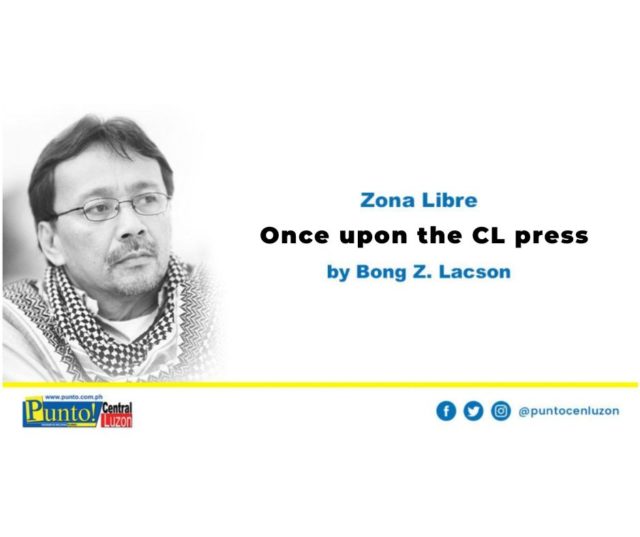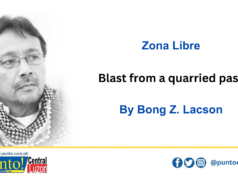- It was July, most probably. Department of Public Information-Region 3 director Ricardo Velasquez Serrano – Kapitan Gigil, fondly – newly assigned to Central Luzon, though a Kapampangan by parentage, asked his senior staff how the office can engage the provincial press in development communications to support the socio-economic and infrastructure initiatives of government.
Freshly schooled in OD (organization development) at the Development Academy of the Philippines, his chief of research, training, and development division suggested the formation of an association of “all working journalists” in Central Luzon, which Serrano readily approved, and tasked the proponent to do the working paper for such association.
The primary consideration laid out in the working paper was membership. Aware of the intramurals between provincial press clubs of the time, acceptance into the proposed regional press organization would be by individual membership with representation not of the press club but of the publication or radio station of the member. Thereby, an inclusive umbrella organization that will not be in conflict with the press clubs in terms of membership.
In a week’s time, backstopped by Fred Roxas, bureau manager of the Philippines News Agency in CL, and Ben Gamos of the Times Journal, the proponent traveled around Central Luzon in a campaign for membership to the new organization.
At the time, there were two press organizations that, unfortunately, were regional only in their nomenclature but not in scope of membership: the Tarlac-based Central Luzon Association of Journalists headed by Carlos Gatdula of Bulletin Today, and the Central Luzon Press Club of Romy Medina of Times Journal domiciled in Olongapo City.
It was naturally to these gentlemen that the trio from DPI deferred – they responded positively to the new organization, but with Medina asking for first right to the presidency. In character, the self-effacing and gracious Gatdula readily conceded, merely requesting that something of his club should be in the name of the new organization, hence: Central Luzon Media Association.
From there, it was a breeze tapping the services of the “old guards” in organizing: Rod Reyes of the Journal Group, along with brothers Jess and Bert Matic of The Reflector (CL’s first and only broadsheet) in Bulacan; Efren Molina of Bulletin Today in Bataan; Pacifico de Guzman of The Monday Post, Pete Salazar of Dahongpalay, and Anselmo Roque of Daily Express along with Isagani Valmonte of Times Journal in Nueva Ecija; Ben and Rose Razon of the Tarlac Star and radioman Ben Gonzales, Feliciano Pasion of Manila Times, and DPI coordinator Luz Ducusin in Tarlac; spouses Elpidio and Susana Curiano of Olongapo News in Zambales.
In Pampanga, members of the Pampanga Press Club enlisted en masse to the CLMA.
Aurora – at that time still part of Region IV-A – nevertheless joined in the person of Rodante Rubio of Malaya.
That the greater mass of members came from the print – both provincial and national newspapers, reflected the state of media obtaining in the region at that time: only Olongapo, Tarlac, Angeles, and Cabanatuan had operating radio stations.
September 24, 1978. At the DPI-3 office in San Fernando, Pampanga, the first set of officers of the CLMA with Romy Medina as president was inducted into office by Public Information Secretary Francisco S. Tatad.
Director Ricardo V. Serrano is the First, while the rest of those mentioned here are the rest of the Founding Fathers of the CLMA. Suffice for this writer to hold on, with honor and privilege, to the title Serrano himself bestowed upon him – “founding proponent.”
CLMA presidents: The first decade
- Romualdo Medina (Times Journal). Loosely organized, absent any constitution and by-laws, CLMA adapted to the standards of media practice – objectivity, fairness, and accuracy – and adopted these as protocols.
- Maximo L. Sangil (Daily Express). The framing of the CLMA constitution and by-laws, engagement of the association in crusades in partnership with the Ministry of Public Information notably: the anti-pollution campaign that forced polluting sugar mills, pulp and paper manufacturing factories in Pampanga, Bulacan, and Bataan to put up pollution-abatement facilities; the anti-illegal gambling drive that resulted to the sacking of a regional Philippine Constabulary commander, provincial commanders and chiefs of police; and the anti-illegal dikes campaign which resulted to the demolition of some 300 dikes encroaching the waterways of Bataan, Bulacan, and Pampanga.
Re-elected in 1981, Max holds the distinction as the only CLMA president who succeeded himself. Successive reelection has since been prohibited.
- Alfredo M. Roxas (Philippines News Agency). All the shibboleths of political campaign – T-shirts, streamers, balloons, food and drinks, leaflets – obtained in the election that saw Fred triumph over Amante Reyes (The Voice). The heavy turnout of voters indicated the rise in membership resulting from the increase in the number of provincial newspapers and radio stations in the region.
- Jesus Matic (Reflector) and Hector P. Soto (Times Journal). With equal number of votes, a coin toss decided not who should be president but who would sit first in the shared presidency. Jess’ half of the term was cut short by his death leaving Toy more than his half-share.
- Jeremias J. Lacuarta (Bulletin Today). A court injunction filed by a disgruntled CLMA director came too late to stop Jerry’s election. Lawyer-friends later questioned the injunction over the CLMA, it being a “social organization” unregistered with the SEC. The CLMA was officially affiliated with the National Press Club. CLMA meetings started to be moved from province to province instead of being centered at the MPI regional office.
- Carlos P. Gatdula (Bulletin Today). His sacrifice of the presidency upon the organization of the CLMA bore fruit six years hence, being the only candidate for president in what turned out to be an acclamation rather than an election. Serious threats to his life constrained Gat to seek temporary sanctuary in the USA ceding the presidency to his executive vice president Bert Padilla (Bulletin Today).
- Benny Rillo (Balita). Along with acting president Bert, Feliciano Pasion (Manila Times) and Rizal Policarpio (Balita) were handily beaten by Benny in the election held in Cabanatuan City.
- Feliciano Pasion (Manila Times). Exchange of gunfire between NPA rebels and the military in an armed encounter in nearby Samal, provided the horrifying accompaniment to Ising’s election to the presidency held in Balanga, Bataan. A revised CLMA Constitution and By-Laws was drafted during his term.
- Jeremias J. Lacuarta (Manila Bulletin). The Constitution and By-Laws was approved overwhelmingly in the general assembly preceding the election. Jerry renewed his call to cleanse the CLMA of media scalawags and extortionists.
(P.S. Reminiscing over events more than four decades back has taken its toll on ageing memory. This is the best reconstruction I can do for a piece celebrating the 44th anniversary of the CLMA held last Dec. 2 at the Hiyas Convention Center, Malolos City. My apologies for lapses.)





